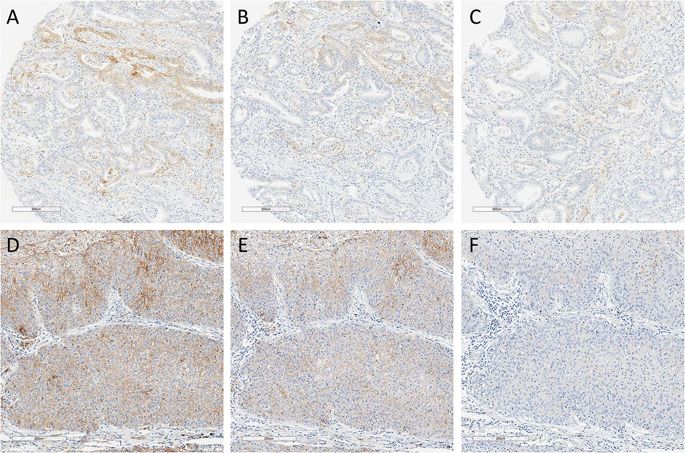Laboratory Investigation ( IF 5.1 ) Pub Date : 2020-01-02 , DOI: 10.1038/s41374-019-0366-y Alexander Haragan 1 , Daniel C Liebler 2 , Dimple M Das 3 , Michael D Soper 3 , Ryan D Morrison 2 , Robbert J C Slebos 4 , Bradley L Ackermann 3 , Jeff A Fill 3 , Andrew E Schade 3 , John R Gosney 1 , Aaron M Gruver 1, 3

|
Immunohistochemistry (IHC) using formalin-fixed, paraffin embedded (FFPE) tissue is limited by epitope masking, posttranslational modification and immunoreactivity loss that occurs in stored tissue by poorly characterized mechanisms. Conformational epitopes recognized by many programmed-death-ligand-1 (PD-L1) IHC assays are particularly susceptible to degradation and provide an ideal model for understanding signal loss in stored FFPE tissue. Here we assessed 1206 tissue sections to evaluate environmental factors impacting immunoreactivity loss. PD-L1 IHC using four antibodies (22C3, 28-8, E1L3N, and SP142), raised against intracellular and extracellular epitopes, was assessed in stored FFPE tissue alongside quantitative mass spectrometry (MS). Global proteome analyses were used to assess proteome-wide oxidation across an inventory of 3041 protein groups (24,737 distinct peptides). PD-L1 quantitation correlated well with IHC expression on unaged sections (R2 = 0.744; P < 0.001), with MS demonstrating no loss of PD-L1 protein, even in sections with significant signal loss by IHC impacting diagnostic category. Clones 22C3 and 28-8 were most susceptible to signal loss, with E1L3N demonstrating the most robust signal (56%, 58%, and 33% reduction respectively; p < 0.05). Increased humidity and temperature resulted in significant acceleration of immunoreactivity loss, which was mitigated by storage with desiccant. MS demonstrated only modest oxidation of 274 methionine-containing peptides and aligned with IHC results suggesting peptide oxidation is not a major factor. These data imply immunoreactivity loss driven by humidity and temperature results in structural distortion of epitopes rendering them unsuitable for antibody binding following epitope retrieval. Limitations of IHC biomarker analysis from stored tissue sections may be mitigated by cost-effective use of desiccant when appropriate. In some scenarios, complementary MS is a preferred approach for retrospective analyses of archival FFPE tissue collections.
中文翻译:

加速不稳定性测试揭示定量质谱法克服了与 PD-L1 免疫组织化学相关的样本储存限制
使用福尔马林固定、石蜡包埋 (FFPE) 组织的免疫组织化学 (IHC) 受到表位掩蔽、翻译后修饰和储存组织中因机制不明确而发生的免疫反应性丧失的限制。许多程序性死亡配体 1 (PD-L1) IHC 检测所识别的构象表位特别容易降解,为了解储存的 FFPE 组织中的信号丢失提供了理想的模型。在这里,我们评估了 1206 个组织切片,以评估影响免疫反应性丧失的环境因素。 PD-L1 IHC 使用针对细胞内和细胞外表位的四种抗体(22C3、28-8、E1L3N 和 SP142)在储存的 FFPE 组织中与定量质谱 (MS) 一起进行评估。使用全局蛋白质组分析来评估 3041 个蛋白质组(24,737 个不同肽)的蛋白质组范围内的氧化。 PD-L1 定量与未老化切片上的 IHC 表达良好相关( R 2 = 0.744; P < 0.001),MS 表明 PD-L1 蛋白没有丢失,即使在因 IHC 影响诊断类别而导致显着信号丢失的切片中也是如此。克隆 22C3 和 28-8 最容易受到信号丢失的影响,其中 E1L3N 表现出最强的信号(分别减少 56%、58% 和 33%; p < 0.05)。湿度和温度的增加导致免疫反应性损失显着加速,通过使用干燥剂储存可以减轻这种损失。 MS 证明 274 种含蛋氨酸的肽仅发生适度氧化,并且与 IHC 结果一致,表明肽氧化不是主要因素。 这些数据意味着湿度和温度导致的免疫反应性丧失导致表位结构变形,使其不适合表位修复后的抗体结合。在适当的情况下,通过经济有效地使用干燥剂,可以减轻对储存的组织切片进行 IHC 生物标志物分析的局限性。在某些情况下,补充 MS 是对档案 FFPE 组织收藏进行回顾性分析的首选方法。











































 京公网安备 11010802027423号
京公网安备 11010802027423号